I was a contestant on the 1/22/2025 episode of Wheel of Fortune, where I won $57,547 (including a trip to Utah and a Ford Bronco Sport). Read more about my audition process, how I studied, a play-by-play of my game, and my retrospective of what preparation ended up mattering.
Key links
- My Bonus Round on YouTube
- GitHub repository, with all my code and flashcards
- Toss-up practice game, written in R Shiny
- Word guessing practice game, written in R Shiny
- Puzzle practice game, written in R Shiny
- A Daily Mail article about my game
My audition process
Being on a game show has been on my bucket list for most of my life. I had loved watching Game Show Network and playing all types of games with friends and family. A math professor in college once shared his experience with being on a few games, which is when it clicked – “Wait, if he can be on one, so can I!”
Around June of 2023, I finally decided to go for it. I researched a few shows with open calls for contestants to learn about the application process. I decided to apply to Wheel of Fortune because I thought I would have the best shot of doing well – it didn’t involve too much luck (like Deal or No Deal) nor require too much obscure knowledge (like Jeopardy). I was good at puzzles, and it was a game about solving puzzles.
One of the main parts of the online application was a one-minute video. I knew I needed to stand out. I decided to write a script and film parts in different locations. I spent all of July, August, September, and October thinking about, writing, or filming the video. Bored on the couch over Thanksgiving, I finally finished editing it and sent it in.
Five days later, I got an email that I had been selected for a 10-minute Zoom interview. Towards the end of the call, the producer dismissed each contestant one-by-one with a “Thanks. We’ll be in touch.” When there were two people remaining, he told us that we would be moving on to an hour-long Zoom interview three days later. Those three days were filled with non-stop watching episodes and playing the app. I did some toss-ups with other applicants, went into a breakout room to solve some half-complete puzzles, and was told by the producer, “Thanks. We’ll be in touch.” Assuming I got the same rejection as the other applicants in my first interview, I felt like I had been removed from consideration. However, just in case, I started making some flashcards of categories and common words.
Until late March 2024 rolls around, and I got an email asking if I was free for a tape date in early April. I was both shocked and stressed – I couldn’t believe I was being considered, but I was only available one of the three days they had proposed. I sent back my availability, didn’t hear anything, and then read online that they had finished filming Season 41 in early April. I was, again, dejected. I sent the contestant manager an email expressing how I’d love to be a contestant on Season 42 and recapped some of my studying techniques I had been using, sharing screenshots of the common words in some categories. I didn’t hear anything.
Until August 2024, when I got a email with the subject line, “Wheel of Fortune – Availability.” The contestant manager said that I was still in their contestant pool for Season 42 (!!!!!) and asked for my availability on tape dates between September and December 2024. I enthusiastically replied, “I AM FREE ON ALL OF THEM” and kicked my studying into high gear.
However, this enthusiasm waned as the weeks and months passed. Come November, I interpreted the silence as another sign that it wasn’t going to work out.
Until November 13th 2024, when I checked my email on the Metro and saw one with the subject line, “WHEEL OF FORTUNE TAPING ON WEDNESDAY DECEMBER 11, 2024!” (all caps theirs, not mine). My jaw dropped and I stared at the faces of everyone else on the train, then back at the email, then back up, then back down, convincing myself it was real. That news set off a flurry of contracts, wardrobe instructions, inviting friends and family as my guests in the audience, and buying flights and hotels. It also kicked off a period of intense preparation.
Preparing for the show
In essence, from the day I found out my tape date (November 13th) to the actual tape date (December 11th), I spent anywhere from 1-4 hours a day preparing to be on the show. When I got the news, I knew I wanted to do well for my ego (it IS a nationally televised show watched by millions), bank account (you can win real money), and, mainly, for myself (this was an incredible opportunity to fulfill a bucket list item, and I wanted to be happy with how it went). So for each day leading up to the show, when I had some free hours, preparing for the show felt like the most important thing I could do. My preparation evolved as I went on and hit on a variety of areas, almost like preparing for a marathon. It can broken into three main categories:
- Strength training
- Cardio
- Mental and physical resilience
Strength training: analysis, flashcards, and memorization
After my auditions in late 2023, I did some basic analysis to make flashcards with the most common words in the main categories and what each category represented (e.g. “Person” does not mean an actual person, but rather a type of person). I studied the flashcards here and there over most of 2024. After I got the word of my tape date, I kicked this up a notch.
First, I got a better puzzle source. Previously, I used a cobbled together spreadsheet of the all puzzles in the five categories from this site. This lacked some key information, such as whether the puzzle was from a toss-up or not, when the puzzle appeared, and puzzles from non-common categories. The quality of my studying relied on the quality of my analysis, which relied on the quality of my data source. In response, I did some basic web scraping of Seasons 30 – 42 from this puzzle compendium. My data science heart was happy with how well-organized it was: each puzzle in its own row, with the category, air date, and which puzzle number it was on the show (e.g. “T2” = the 2nd Toss-up). This gave me 21,573 puzzles to work with.
This analysis became the engine behind made my flashcards, which I worked to memorize. I re-upped my “most common words by category” analysis and added in “most common words in the Prize Puzzle” (excluding little words like THE). Given that the Prize Puzzle describes the prize, and the prize is often a trip to a tropical place, it’s no surprise that the most common words are things like DAY, BEACH, ISLAND, SEA, TIME, VACATION, BLUE, SAND, and FUN.
I focused a lot on letters since that’s the basis of the game. I created multiple mnemonics to remember common letters and letter patterns. Many existing sites online already pointed out that EAT IRONS are the most common letters across all puzzles. (According to my data, it’s technically EAITONRS, but the phrase is so easy to remember that it’s not worth splitting hairs over.) The next common letters became their own mnenomic: Let’s Call Her Dad, Guys. Many articles also opined about the best consonants and vowels to guess in the Bonus Round, where they give you RSTLNE. From my data, the best vowel is O (2,886 appearances) with A as a close second (2,845 appearances). As for Bonus Round consonants, the most common letters are GHDPCYB – remembered with the phrase Go Home, Don’t Panic, Call Your Brother.
I also analyzed common letter combinations, focusing on the most common consonants (R, S, T, L, N) in both an early and a late spot in the word. I was particularly interested to know what letter usually came first when these common consonants were second in a word. For example, for words that start with _ R ….., what letter does that word usually start with? Of the 4,681 puzzles in my dataset that have an R in the second spot, here are the counts:
- T – 702 (most common = TREE)
- B – 665
- F – 659
- G – 584
- P – 518
- C – 508
- A – 353
- D – 300
- O – 184
- W – 118
- I – 40
- M – 21
- E – 17
- U – 7
- K – 4
- J – 1 (from the puzzle ROBERT DOWNEY JR.)
Memorizing this whole list wouldn’t be worth it, so I just focused on the most common first letters and made a mnemonic to remember the order. For R, it was The Buried Fortune Gave Pirates Coins (thinking “arr” like pirates). I did the same thing for other common letters, such as L (“lollipop,” Pretty Candy For A Baby), H (“hair,” Comb Those Stupid Wispy Pieces), and P (“paradise,” Soak Up An Ocean). Those mnemonics all went on flashcards.
I also looked at common endings of words. I already knew generic English word endings like –TION or –ER. But I wanted to know more Wheel-specific patterns. Again, I looked at common consonants in the last or second-to-last letter spot. Let’s look at …NE as an example. Among the 120 words that ended in NE, the most common were ONE, LINE, MACHINE, SUNSHINE, PHONE, and WINE. Other common and interesting endings include:
- End in LE = LITTLE, APPLE, DOUBLE, TABLE, WHOLE, INCREDIBLE
- End in L = ALL, SCHOOL, BEAUTIFUL, POOL, WILL, BALL, BOWL
- End in T = IT, OUT, AT, HOT, BEST, GREAT, THAT, WHAT
- End in N = IN, ON, AN, DOWN, MAN, CAN, GREEN, FUN, TELEVISION, VACATION
For each other common endings, I wrote them on a flashcard, organized by word length. That way, if I saw a six-letter word that ended in LE, I knew to think about LITTLE or DOUBLE or BOTTLE or CIRCLE. Or a five-letter word that ended in N, it could be GREEN or OCEAN or TRAIN.
Then, I dug into common two- and three-letter words. For two-letter words, there were so few that I just memorized them in some grids based on the first and last letter. Ends in an N? AN, IN, ON. Starts with an O?OF, ON. Doesn’t share a first or last letter with another common two-letter word? MY, UP, TO. For three letter words, I used Chat-GPT to make a poem using the top 16 three-letter words and then set it as my phone background until I memorized it:
FOR a DAY that’s BIG AND NEW / THE DOG is OUT and so ARE YOU / with PIE and ICE and TEA that’s HOT / ALL play, no work, and OFF we trot!
In the final weeks of studying, once I was done memorizing many of the things described above, I did two more techniques. First, I made custom phone backgrounds to help keep common words front of mind. I wanted my brain to auto-complete the puzzles, so I wanted common words to be floating around in my head. To do this, I again took advantage of my phone wallpaper. I made 25 wallpapers of the most common 15 words starting with each letter (sorry, X, you didn’t make the cut). I set up an iPhone Shortcut so they rotated each time I opened my phone. I didn’t try to memorize these, as my short-term memory was getting a bit full from flashcards and mnemonics. But I hoped seeing these words regularly throughout the day put them into my subconscious, ready to pop in for a mental “auto-complete.”
Second, I analyzed common words with some arbitrary letter patterns. (All credit for this idea goes to my brother, Steve.) Once again, we focused on common consonants (R, S, T, N). We used a R script I wrote to find common words that had certain letters in a certain spot. The goal was, again, to help my brain auto-complete or think about possible words in the early stages of a puzzle. For example, if I saw _ _ _ _ N _, it would usually end in ND (AROUND, ISLAND) or NG (DIVING, EATING). Alternatively, seeing _ _ R _ _ were often words like PARTY, FIRST, or WORLD. Other memorable patterns were:
- _ _ S _ _ _ SS = BUSINESS
- _ _ _ _ _ _ N = CHICKEN, CAPTAIN, ITALIAN, KITCHEN
- _ _ T _ _ _ _ = KITCHEN, NOTHING, NATURAL
We made a sheet of ~30 of these common letter patterns for words 5 to 8 letters long, and I finished memorizing them on the plane en route to LA.
Cardio: puzzles & episodes
As much as analysis and memorization felt productive, I knew that a big part of being prepared was working the muscle of solving puzzles over and over and over. Every day, I tried to get my reps in three ways: watching episodes, playing the phone app, and playing web apps that I wrote. I watched 1-3 episodes a day, which included all of season 42 (up to that point). I also played the phone app during my commute or before bed, clocking over 14 hours and 1,000 games (500 regular, 500 bonus round) in the month leading up to the show.
I also wrote three web apps (in R Shiny) to get more puzzles in my face. The first game is for toss-ups, using past toss-up puzzles in the classic toss-up fashion. There’s an initially blank puzzle, with one random letter revealed at a time until you press “Solve.” There’s a brief pause when you mentally (or literally) say what you think the answer is, and then the answer is revealed. The second game gives a category and partially complete word, which prompts you to think about what words could fit the pattern. The third game is a simulated regular puzzle round (without the money) where you enter a letter and it either appears in the puzzle or in the “Used Letters” section. I would play these games as much as I could, and they inspired a lot of the analysis described above. For example, I once got stumped guessing any six-letter word ending in NE, which pushed me to do a quick analysis and make a flashcard for it.
Finally, the producers told us that five of the six shows taping on December 11th would have the same theme (“Winter Wonderland”). That meant I had an 83% chance of being on a show with that theme, and I knew the theme always appeared in at least the first toss-up. Therefore, I used ChatGPT to make 200 puzzles across the common categories that fit the theme “Winter Wonderland.” I fed these into my three Shiny apps and got familiar with common wintery words.
Mental and physical resilience: sleep, gym, mental plan, attitude, and food
I also knew that a big part of my performance on the show would be outside of the puzzles themselves. I wanted to be mentally and physically prepared – if I was an expert puzzle solver but couldn’t think straight, then it wouldn’t matter.
One big component was sleep. The better rested I was, the better my brain would work. For the week leading up to the show, I slept as much as possible, doing things like leaving a party early to be in bed by 9:30pm. The day before the show, I flew to LA from DC. I tried to stay on East Coast time, eating dinner at 4:00pm PST and going to sleep by 8:00pm, so that my 4:00am wakeup call the next morning didn’t feel so bad.
I consistently mentally rehearsed my strategies for certain situations, so that if they arose, I would know what to do instinctually. I knew there would be a lot of split-second decisions I’d need to make, and I wanted to think through as many of them in advance as possible. Some of these strategies included:
- What consonants should you call? If you have an educated guess for a letter that could be there, like THE or AND or an –ING or guessing S in the category “Things”, go with that. Otherwise, follow the frequency order: E, A, T, I, R, O, N, S, L, C, H, D, G.
- What should you do if you land on the Express wedge? Take it, always. Control of the board is even more valuable than $1,000 per consonant!
- When should you solve early versus keep spinning to win more money? Always solve the Prize Puzzle ASAP. Keep spinning if you’re at less than $1,000. Keep spinning if it’s towards the end and you’re not quite in first place.
- Should you pick up the Mystery Wedge? If it was early, yes. If it was later in the puzzle and you know the answer, no.
- When should you buy vowels? Frequently, but with caution. If you don’t know what consonant to guess next, make an educated guess with a good vowel.
- How should you buy yourself time to think? Don’t look at the wheel as it spins around – look at the board instead. If you get to the Bonus Round, take a looooooooong time picking the three consonants and a vowel. You can’t really get buzzed out, so it’s free thinking time before the 10-second timer.
- When should you guess a toss-up? When you think you know 90% of it, hoping that you can get the final 10% in the seconds between buzzing and Ryan calling on you. If you only buzz in when the puzzle is obvious to you, it’s likely obvious to one of the other contestants!
- How should you call letters in the Bonus Round if you think you know the puzzle? Don’t box yourself in, because what if your guess is wrong? Go with common letters that are in your guess, but maybe use one letter to diversify your options in case you’re wrong.
Another component was my mental resilience and attitude. I monitored my self-talk in the weeks before the show. Initially, I found myself leaning towards thinking, “But what if I bomb!” or telling co-workers, “I hope I don’t embarrass myself.” I realized that thinking about the show that way made me feel less confident. Instead, I sought to speak optimistically, even if I still felt nervous and doubtful inside, thinking things like “I am prepared” or telling co-workers “I don’t know how it’ll go, but I’ll do my best.” It sounds cliché, but it helped! I also practiced deep breaths in moments of stress. There were many moments in the month before the show when I would think ahead to being on national TV and feel a wave of nerves. In those moments, I consciously took a deep breath. I wanted it to become a habit so that when I felt even more nervous on the actual day of the show, I would remember to breathe. Lastly, I kept my expectations very low. When I first got the news, I excitedly made a “goal list” with things like “win $50,000” or “win the prize puzzle” or “win all three triple toss-ups.” However, I deleted the list after a few days. I got the sense that ballooning my expectations would only add to the pressure and nerves that I felt. Instead, I revised my list to be much more attainable:
- Win at least one toss-up
- Win over the house minimum ($1,000)
- Have fun!
Logistically, I also wanted to minimize risk and new variables on the tape day. I packed a hefty bag to be prepared: medicine, snacks, backup glasses (you never know!), and breakfast and lunch (they provided both, but I didn’t know what or how it would be beforehand). I knew the day would be long and stress-filled, so I wanted to control as much as I could.
Lastly, I also prepared physically. Many past contestant testimonials remarked how heavy the wheel was. I stepped up my visits to the gym and focused primarily on my biceps and shoulders. I also knew that the producers wanted you to smile a lot on the day of the show, as they emphasized it during the audition. This part may sound a bit nuts, but stick with me: to prepare to smile a lot on the tape day, I practiced holding a smile. I usually did it at night while I played my WOF app. Right when I got the news, the longest I could smile before my cheeks gave out was around 7 minutes. After my regular practice, my last smile hold a few days before the show was 47 minutes long!
The play-by-play of my game
I played alongside two other contestants, Sabrina and Steve. I stood in the space closest to Ryan, with Steve to my left and Sabrina next to him. The spinning order moves clockwise, meaning I would go after Sabrina. (This will matter!)
The show starting was utterly surreal. I took a deep breath before the first toss-up and tried to clear my head. Unfortunately, I had everything except the last word, and Sabrina beat me to it. The contestant introductions went well, and I mentally prepared for the second toss-up. An unusual combo appeared with the category “What Are You Doing?”: one long word and one two-letter word. I had a hunch the second word was UP. I saw an L appear in the middle of the first word, had LEVELING UP pop in my head, and hit the buzzer. Unfortunately, one second later, I realized that LEVELING was not enough letters. I said, “Nope” and watched a few more letters appear before Sabrina solved it as SNUGGLING UP. At the commercial break, I shook it off, excited to get into our first puzzle.
For the first puzzle, Sabrina had a perfect run. All of her spins landed and she guessed correctly every time. Given her strength in the toss-ups, I suspected she knew the answer even as she kept guessing. The whole time, I was trying to solve as quickly as I could since I knew I was next. I never got the chance.
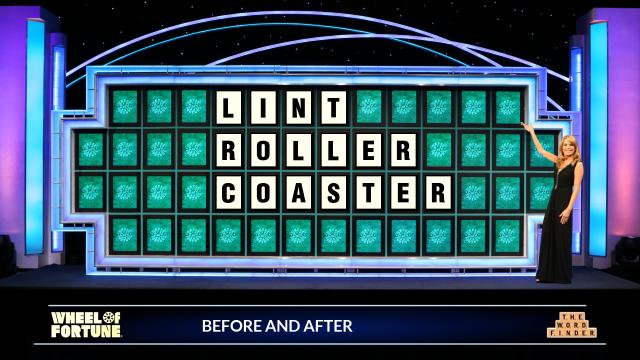
I got to start the second puzzle.
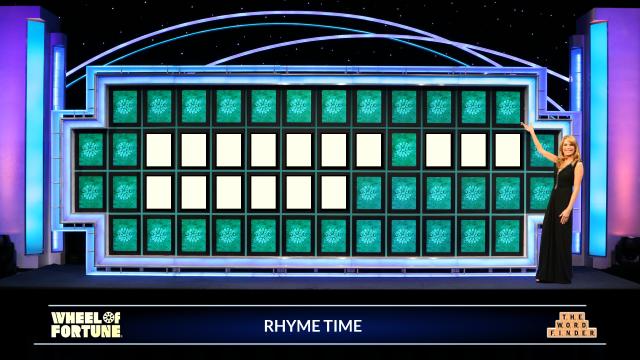
From the category (“Rhyme Time”), I figured the middle “_ _ _” was AND. I guessed N and got one. I spun again and got one D, and then bought an A. That worked, but I didn’t have any idea for the other two blank words.
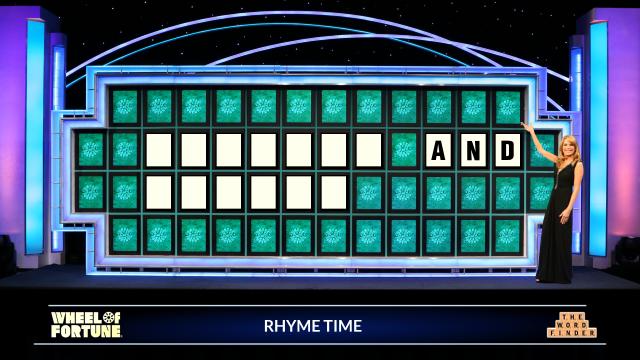
My planned strategy was to buy a vowel, which I did with an E. Unfortunately, it wasn’t there, and it didn’t get back to me, with Sabrina solving THRILLS AND CHILLS.
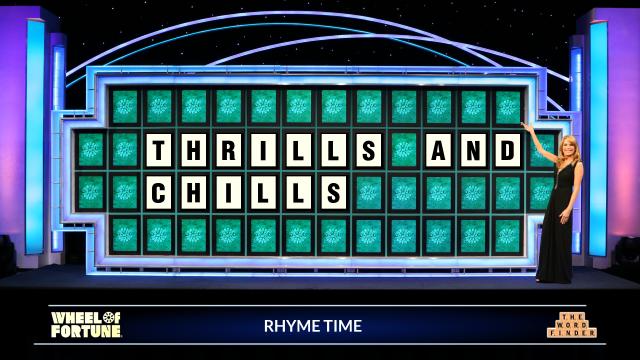
At this point, Sabrina had won both toss-ups and both puzzles, totaling over $9,000. I had $0. While the producer was telling us about the upcoming prize puzzle, I tuned her out to hype myself up. This was the part of the game where my mental resilience needed to come through. I told myself, “You got this. You’re still in this. You’re going to come back.” Earlier in the day, during our orientation, the producers had given us the advice to “stay engaged,” citing numerous times where someone came back from last place in the blink of an eye. That’s what I intended to do.
Steve started the Prize Puzzle. His guess wasn’t there. Sabrina had some good guesses but got hit with a Bankrupt. When the puzzle got to me, I had:
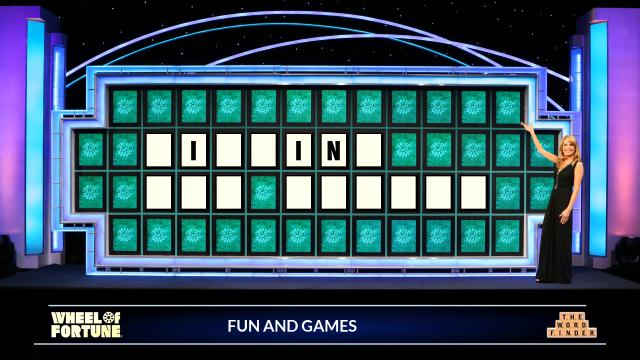
I knew that T was a safe guess from the _ _ E, so I called it out. I got more than I expected:
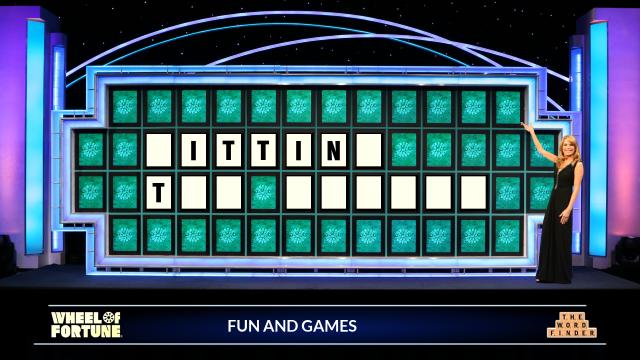
I quickly saw that it was HITTING THE something. I didn’t quite know the last word, so I bought a safe E.
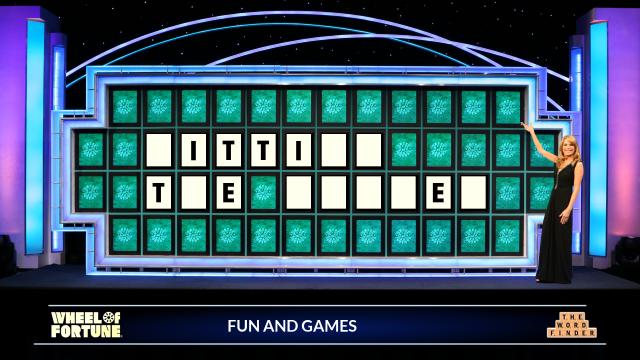
Suddenly, the winter decor inspired me and the phrase HITTING THE SLOPES popped into my head. I paused for a heartbeat, confirming that it was a valid guess (i.e. it didn’t use any letters that had already been guessed, and the length of the words matched). It was. I knew I had a choice: spin again to guess a letter I thought was in there (like S) but risk losing my turn, or try and solve outright. I quickly decided to try and solve since it was a Prize Puzzle, which was one of my pre-determined strategies. It paid off.
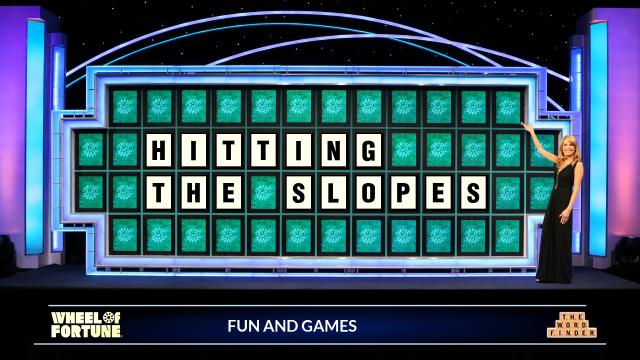
I can’t really remember much of what Ryan said except him asking “Do you ski?” I didn’t even hear him say what the prize was – I was far too overwhelmed! It was only when I went to sign the paperwork after the show that I actually saw where the trip went – ha!
We took another commercial break, and I felt energized. The final task: make enough to beat Sabrina to make it to the Bonus Round. I peeked at the scoreboard and saw it was very close: my $9,392 to her $9,650. The Triple Toss-Ups came and went. Sabrina got the first one, I got the second one, and we got buzzed out for the third one. Sabrina and I remained nearly tied at $11,392 to $11,650.
The next puzzle, I had SUGAR early on, but I couldn’t figure out the second word for the life of me.
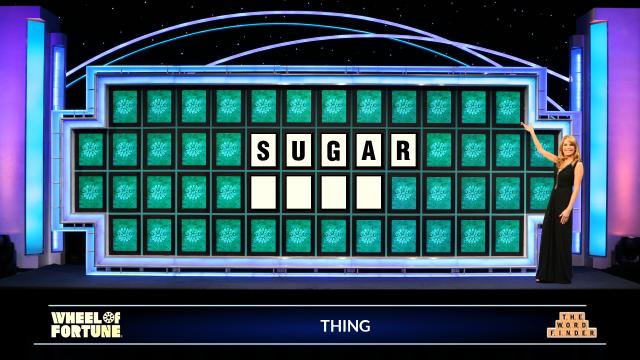
SUGAR CUBE? No, the U in CUBE would have been shown. SUGAR SPOON? No, too long. When it got to me, I blindly guessed an N, which wasn’t there. Thankfully Steve solved it (SUGAR BOWL), meaning me and Sabrina stayed closely tied.
Surprisingly, we got a rare fifth puzzle. I knew that I needed to win the next puzzle to go to the bonus round. When I saw “Occupation” come up as the category, I got a bit nervous. It wasn’t that common of a category (22nd according to my list), so I hadn’t studied it much. One thing I did know from times I had seen it was that an R often showed up at the end (e.g. DOCTOR, ACTOR, HAIRDRESSER). When the speed-up round started, here’s how it got to me:
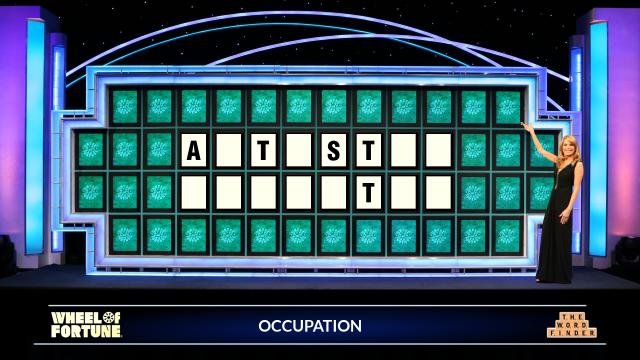
Thankfully, Steve and Sabrina hadn’t guessed an R, so I did. I got three:
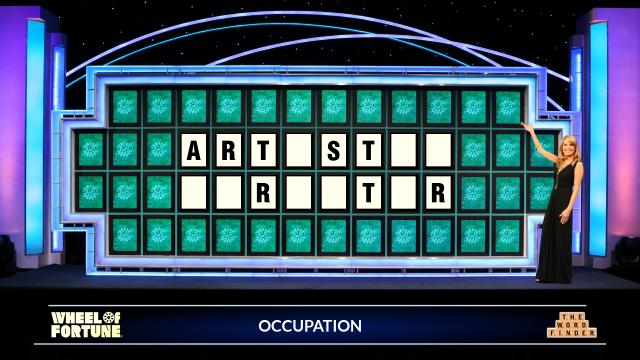
In the matter of one second, I saw that the second word was DIRECTOR, and my brain auto-completed the first word to ARTISTIC. I called it out, and it was right!
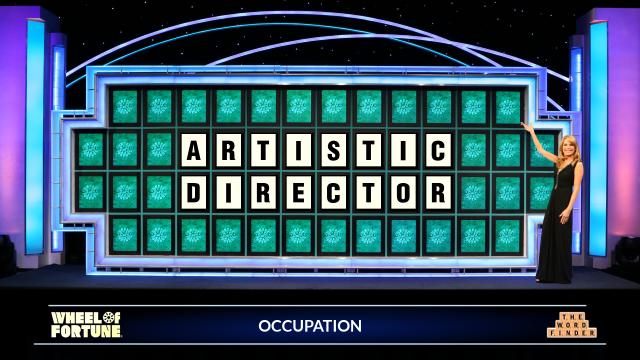
Again, I was overwhelmed with what was going on. I only realized that I was going to the Bonus Round when Ryan walked past and told me, “I’ll be right back.” I had a few seconds to myself where I had another moment of self-talk. This time, it was to lock in, smile, and think about what category I would pick for the bonus round. I knew that “Phrase” was my top choice since I had spent a lot of time with two- and three-letter words. To my great relief, it was on the list.
I had a few minutes before the bonus round started, where the crew wheeled in the extra floor riser and prize mini-wheel. I took advantage of this time. I said my three-letter poem and Bonus Round consonant mnemonic (Go Home, Don’t Panic, Call Your Brother) out loud to remind myself. I reminded myself to be slow in guessing consonants to get extra thinking time. I took a LOT of deep breaths.
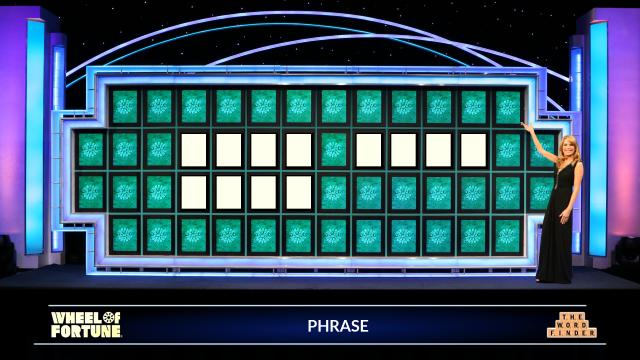
When the puzzle was revealed and it was three four-letter words, I mentally thought, “…Shit.” I had extensively studied two- and three-letter words. I had done some letter placement memorization for words five letters and longer. A glaring hole existed in my study strategy: four-letter words. Vanna revealed some letters to give me:
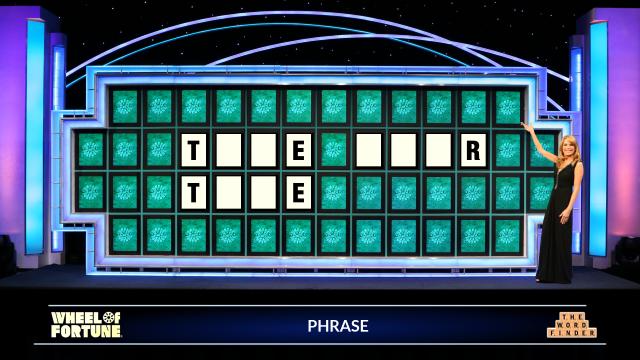
I immediately knew the middle word was YOUR, and would confirm it when I guessed the O (which I always planned to do). My brain started working in overdrive trying to think of words that fit T _ _ E. I threw out an H because it was a common letter and TH is a common pattern. (In hindsight, bad guess. There are no past WOF words that are TH_E or T_HE.) I kept thinking and suddenly came up with the word TIME – it fit and was a pretty common word. I mentally put it in the third spot and thought “hmm YOUR TIME”, when suddenly the word TAKE popped into my head. I called M to confirm my guess. For my third guess, I didn’t want to guess K (from TAKE) since it was a very unusual letter. I diversified in case it I was wrong about TIME or TAKE and guessed C. (Again, bad guess. No words that are T_CE. Oh well!). I ended with O. Vanna revealed what I had expected:
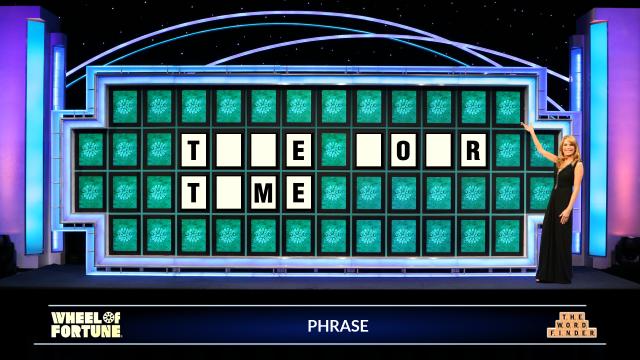
I muttered under my breath, “I think I know it.” I heard Ryan repeat “She says she thinks she knows it.” I still kept thinking, not wanting my hubris or enthusiasm to be my downfall. I came up with TYPE as another word that could fit up front. It didn’t matter – I called out TAKE YOUR TIME and it was right!
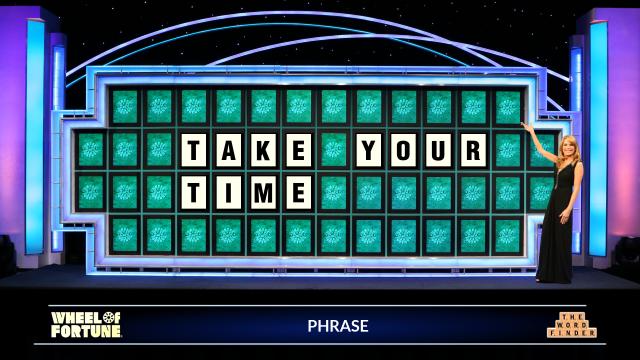
The next minute was a blur. I turned back to Ryan and noticed him hesitating to reveal the card. The host only does that when it’s something other than the minumum (and common) $40,000. My eyes went wide. I heard him say “something something CAR!” and I yelped. I quickly hugged my two guests (my brother, Steve, and sister-in-law, Annie). I said out loud, “I don’t have a car! I always borrow hers!” which you can hear during the video! Then I heard the distant voice of a producer yell “GO TO THE CAR!” I told myself not to trip. Vanna opened the car door and I got in. Being face-to-face with her added to the full list of overwhelm. I think I went, “Hi Vanna!” We then filmed the end of episode chat, I signed more paperwork, and my time as a contestant was officially over.
What preparation ended up mattering
During my preparation month, I knew that my strategies were covering a lot of ground. It’s almost like I was a golfer preparing my club bag. I didn’t know which clubs I would end up using, but I wanted to be prepared for whatever situations I found myself in. Now that the show is over, let’s look back to see what I ended up using.
Here’s what I prepared that ended up mattering:
- Mental resilience and self-talk, to keep a level head throughout a stressful and tumultuous game
- Rehearsing my strategies so my in-game decisions were second nature
- Solving hundred and hundres of puzzles from past episodes, the phone app, and my web apps – it helped to train the muscle that got me all of my early solves and good guesses (like “Occupations” usually end in an R)
- All of the physical preparation – I was able to give the wheel a hefty spin without much strain (although it may not have gone that far) and my cheeks didn’t get tired from all the smiling
- During the Triple Toss-Up, I knew the word “friend” would be in the second puzzle since it matched the Triple Toss-Up patterns I learned from watching episodes and reviewing my data
- My web app that prompted an incomplete word – that’s exactly the skill I had to use when faced with twoT _ _ E in the Bonus Round
And here are the things I spent time on that didn’t end up mattering:
- Many parts of my letter analysis to know what consonants to guess next – I barely had control of the wheel!
- Memorizing the common words in each category – basically none of them came up in any of the toss-ups or puzzles
Overall, even though the vast majority of my preparation didn’t come into play, I FELT prepared. That helped me feel comfortable during the show, which allowed my brain function semi-normally and auto-correct during my early solves.
The balance of luck
Wheel of Fortune involves a lot of luck. Here’s how Lady Luck treated me.
Times when I got lucky:
- Sabrina hitting a Bankrupt
- “Phrase” being one of the available bonus round categories
- The answer to the speed-up round puzzle popping in my head
Times when I got unlucky:
- Sabrina running the first puzzle
- No E in _ _ _ _ _ _ _ AND _ _ _ _ _ _
- Hitting Bankrupt in the fourth puzzle
- My two premature toss-up buzzes
My overall takeaways
While Wheel of Fortune is a show that features a heavy dose of luck and randomness, preparation still can make the difference. Overall, I had an unbelievable time – the 12 hours on set felt like a lifetime, and the 22 minutes on stage felt like a blur. I’m grateful for the producers, stylists, audio techs, and everyone else who works at Sony Studios for making the show come to life. I still can’t believe I was selected as a contestant and had the show that I did. If anything, use my experience as a sign to go for the long shot – it might just pay off!
Other interesting bits of analysis
You can find all of my analysis, flashcards, and tips in my GitHub repository. Here are some other things I found!
- Of the 72 spaces on the wheel (24 Wedges with three spaces each), 11 will make you lose your turn. That means there’s only an 84.7% chance that when you spin, it’ll remain your turn. Be careful!
- To my knowledge, Wheel of Fortune has never provided an official breakdown of Bonus Round prize cards in the 24 spaces on the Bonus Round wheel, except that exactly one is the $100,000 (or the million). However, assuming cards are pulled at random, we can look at what cards were revealed during the 195 episodes in Season 40 to make an estimation:
- 12 cards = $40,000 (100 episodes)
- 7 cards = Car (59 episodes)
- 3 cards = $45,000 (20 episodes)
- 1 card = $50,000 (6 episodes)
- 1 card = $100,000 or million (10 episodes)
Resources I used
- This compendium with tables of all clues from each season
- Write ups of each episode, which I used as practice for seeing clues from incomplete puzzles and reading player testimonials
- This post about the the ideal mindset during your game
- These two NYTimes articles about strategies, which got my gears turning
- ChatGPT helped me write the Shiny apps – it’s been nearly a decade since I’ve last built something in Shiny, so I was grateful for the help.